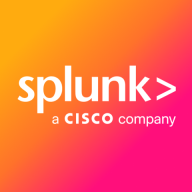

Splunk Enterprise Security and Microsoft Business Intelligence (BI) compete in the domain of data analytics and enterprise solutions, focusing on security and business intelligence analytics. Splunk Enterprise Security seems to have an edge due to its robust threat detection capabilities and seamless integration with various security solutions, particularly fitting for environments heavily focused on cybersecurity needs.
Features: Splunk Enterprise Security offers advanced incident review, customizable dashboards, and strong data integration options facilitating real-time data analysis and visualization. It provides features such as security essentials library, risk-based alerting, and integrated threat intelligence management. Microsoft BI, in contrast, provides powerful data visualization, integration with Microsoft Office tools, and flexible data connectivity options. Notably, it features robust integration with Microsoft products, a user-friendly interface, and the ability to easily connect to a variety of data sources for creating dynamic visualizations.
Room for Improvement: Splunk Enterprise Security could improve its migration process to Splunk Cloud and minimize complexities in managing multiple pods. Users also indicate that improved user interfaces and more affordable pricing tiers for smaller enterprises could enhance its offerings further. Microsoft BI could benefit from offering more complex data visualization options, improving its integration with non-Microsoft data sources, and reducing the learning curve associated with its advanced features.
Ease of Deployment and Customer Service: Splunk Enterprise Security provides a straightforward process for customizing and testing detections but occasionally requires customer support for complex setups. It offers quick deployment and strong customer service support. Microsoft BI offers easy integration with existing Microsoft products, enhancing customer service and user adoption, though some elements of the initial setup can be complex for non-technical users. Its customer service is generally accessible and helpful, provided users are familiar with Microsoft products.
Pricing and ROI: Splunk Enterprise Security employs flexible pricing models that allow for cost distribution across business units, which is beneficial for budget control, but its pricing might be premium for smaller businesses. It offers significant ROI by improving security operations and reducing incident resolution times. Microsoft BI offers an attractive pricing strategy with low costs compared to competitors, making it a cost-effective solution for comprehensive business intelligence capabilities, offering a strong ROI especially advantageous for organizations already integrated within the Microsoft ecosystem.
In a world surrounded by data, tools that allow navigation of large data volumes ensure decisions are data-driven.
Power BI is easy to deploy within an hour, providing robust security against data leaks.
The documentation for Splunk Enterprise Security is outstanding. It is well-organized and easy to access.
We couldn't calculate what would have been the cost if they had actually gotten compromised; however, they were in the process, so every investment was returned immediately.
On average, my SecOps team takes probably at least a quarter of the time, if not more, to remediate security incidents with Splunk Enterprise Security compared to our previous solution.
The significant drawback I notice is that Microsoft's size makes it hard to get specific change requests addressed unless they involve a bug.
We have a partnership with Microsoft, involving multiple weekly calls with dedicated personnel to ensure our satisfaction.
The support is good because there is also a community available.
We have paid for Splunk support, and we’re not on the free tier hoping for assistance; we are a significant customer and invest a lot in this service.
I have had nothing but good experiences with Splunk support, receiving timely and helpful replies.
We've had great customer success managers who have helped us navigate scaling from 600 gigs to 30 terabytes.
You expect only a small percentage of users concurrently, but beyond a thousand concurrent users, it becomes difficult to manage.
With increasing AI capabilities, architectural developments within Microsoft, and tools like Fabric, I expect Power BI to scale accordingly.
As more data is processed, performance issues may arise.
We currently rely on disaster recovery and backup recovery, which takes time to recover, during which you're basically blind, so I'm pushing my leadership team to switch over to a clustering environment for constant availability.
They struggle a bit with pure virtual environments, but in terms of how much they can handle, it is pretty good.
It is easy to scale.
In terms of stability, there's no data loss or leakage, and precautions are well-managed by Microsoft.
We typically do not have problems with end-user tools like Excel and Power BI.
It is very stable for small data, but with big data, there are performance challenges.
They test it very thoroughly before release, and our customers have Splunk running for months without issues.
Splunk has been very reliable and very consistent.
It provides a stable environment but needs to integrate with ITSM platforms to achieve better visibility.
This makes Power BI difficult to manage as loading times can reach one or two minutes, which is problematic today.
Access was more logical in how it distinguished between data and its formatting.
Microsoft updates Power BI monthly based on user community feedback.
Improving the infrastructure behind Splunk Enterprise Security is vital—enhanced cores, CPUs, and memory should be prioritized to support better processing power.
Splunk Enterprise Security is not something that automatically picks things; you have to set up use cases, update data models, and link the right use cases to the right data models for those detections to happen.
For any future enhancements or features, such as MLTK and SOAR platform integration, we need more visibility, training, and certification for the skilled professionals who are working.
I found the setup cost to be expensive
Power BI isn't very cheap, however, it is economical compared to other solutions available.
The pricing for Microsoft Power BI is low, which is a good selling point.
I saw clients spend two million dollars a year just feeding data into the Splunk solution.
The platform requires significant financial investment and resources, making it expensive despite its comprehensive features.
I find it to be affordable, which is why every industry uses it.
In today's data-driven environment, these tools are of substantial value, particularly for large enterprises with numerous processes that require extensive data analysis.
Within the organization, Microsoft Power BI is used to create dashboards and gain insights into data, enhancing data-driven decision-making.
To reduce the need for highly skilled personnel, we can engage someone who is just familiar and has a basic understanding of Microsoft Power BI, while AI can handle the major tasks through either agent AI or requirement analysis.
This capability is useful for performance monitoring and issue identification.
I assess Splunk Enterprise Security's insider threat detection capabilities for helping to find unknown threats and anomalous user behavior as great.
Splunk Enterprise Security provides the foundation for unified threat detection, investigation, and response, enabling fast identification of critical issues.
| Product | Market Share (%) |
|---|---|
| Microsoft Power BI | 12.7% |
| Tableau Enterprise | 9.2% |
| Amazon QuickSight | 4.5% |
| Other | 73.6% |
| Product | Market Share (%) |
|---|---|
| Splunk Enterprise Security | 8.7% |
| Wazuh | 9.3% |
| IBM Security QRadar | 6.5% |
| Other | 75.5% |


| Company Size | Count |
|---|---|
| Small Business | 134 |
| Midsize Enterprise | 57 |
| Large Enterprise | 165 |
| Company Size | Count |
|---|---|
| Small Business | 110 |
| Midsize Enterprise | 50 |
| Large Enterprise | 257 |
Microsoft Power BI is a powerful tool for data analysis and visualization. This tool stands out for its ability to merge and analyze data from various sources. Widely adopted across different industries and departments, Power BI is instrumental in creating visually appealing dashboards and generating insightful business intelligence reports. Its intuitive interface, robust visualization capabilities, and seamless integration with other Microsoft applications empower users to easily create interactive reports and gain valuable insights.
Splunk Enterprise Security delivers powerful log management, rapid searches, and intuitive dashboards, enhancing real-time analytics and security measures. Its advanced machine learning and wide system compatibility streamline threat detection and incident response across diverse IT environments.
Splunk Enterprise Security stands out in security operations with robust features like comprehensive threat intelligence and seamless data integration. Its real-time analytics and customizable queries enable proactive threat analysis and efficient incident response. Integration with multiple third-party feeds allows detailed threat correlation and streamlined data visualization. Users find the intuitive UI and broad compatibility support efficient threat detection while reducing false positives. Despite its strengths, areas such as visualization capabilities and integration processes with cloud environments need enhancement. Users face a high learning curve, and improvements in automation, AI, documentation, and training are desired to maximize its potential.
What Are the Key Features of Splunk Enterprise Security?In specific industries like finance and healthcare, Splunk Enterprise Security is instrumental for log aggregation, SIEM functionalities, and compliance monitoring. Companies leverage its capabilities for proactive threat analysis and response, ensuring comprehensive security monitoring and integration with various tools for heightened operational intelligence.
We monitor all BI (Business Intelligence) Tools reviews to prevent fraudulent reviews and keep review quality high. We do not post reviews by company employees or direct competitors. We validate each review for authenticity via cross-reference with LinkedIn, and personal follow-up with the reviewer when necessary.